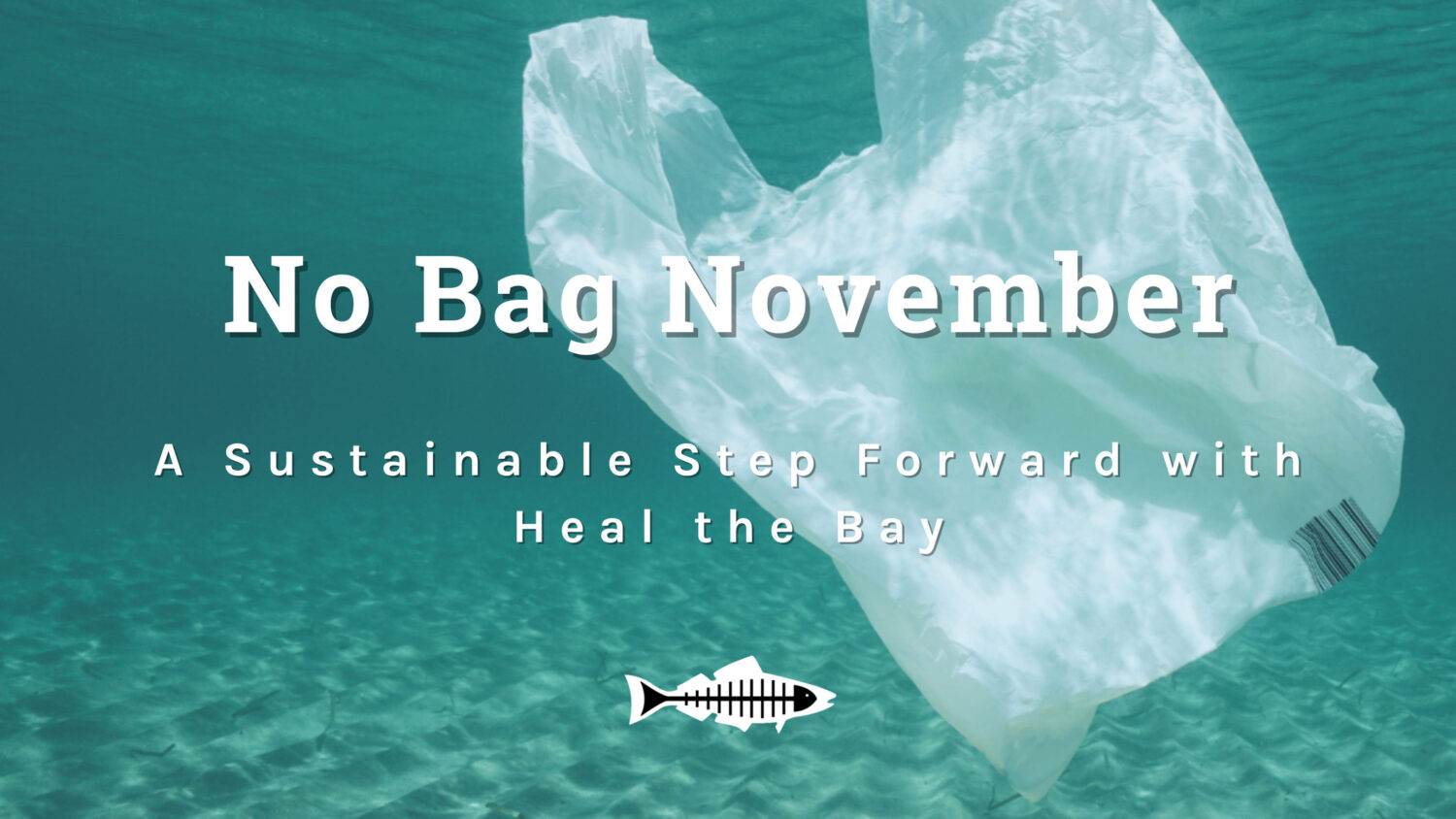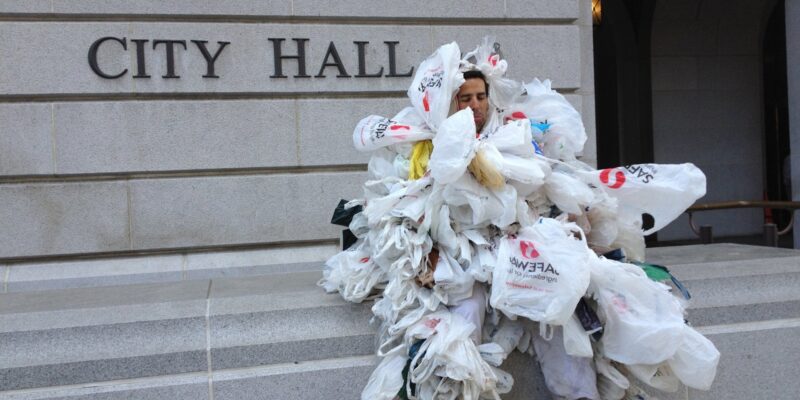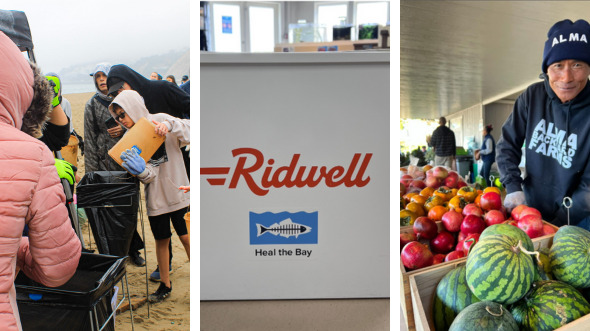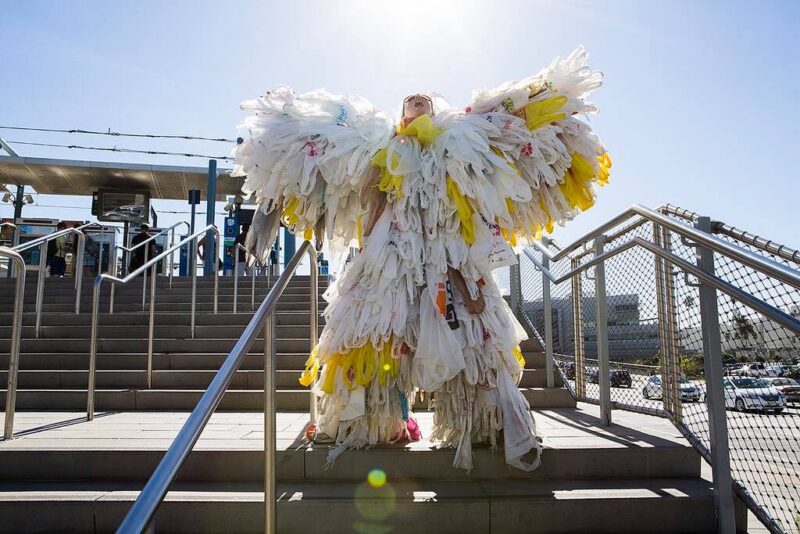Embrace and Commit to “No Bag November”: A Sustainable Step Forward with Heal the Bay

In the not-so-distant past, disposable plastic bags were a ubiquitous sight, fluttering in the wind and littering our streets, waterways, and beaches. But Los Angeles took a pioneering step in 2014 and implemented a city-wide bag ban in grocery stores. The state of California soon followed, after dozens of districts across the state banned single-use plastic bags, and since then, light weight single-use plastic grocery bags have been officially outlawed. And yet, single-use bags have slowly crept back into our lives.
This month, Heal the Bay launched the “No Bag November” campaign, urging everyone to embrace and recommit themselves to declining single-use plastic bags, and digging up their reusable bags from the depths of their pantries to reaffirm our commitment to a plastic-free Los Angeles. In this blog post, we’ll explore the history of the plastic bag, the nuances of the bag ban, and what we can do to create lasting change.
The Story of the Plastic Bag: A Brief History and the Bag Ban
Behold the infamous “Plastic Bag Monster” at the height of the single-use-plastic bag epidemic before the passage of SB270.
The Rise of the Plastic Bag: Disposable plastic bags became an environmental scourge as their production skyrocketed in the late 20th century. Their lightweight nature meant that, after being used for mere minutes typically, they could easily escape from trash cans and pollute our oceans and landscapes. These bags, while only a fraction of all single-use plastics, are particularly problematic due to the challenge of recycling the thin film which often clogs recycling machinery.

The “Plastic Bag Monster” awaits their fate as the plastic bag ban becomes law, first in Los Angeles, then across California in 2016.
The Bag Ban: California’s bag ban, Senate Bill 270, was implemented in 2016 after a multi-year fight and statewide public vote (Prop 67), and was a significant step towards reducing plastic pollution. This law banned single-use plastic carry-out bags from groceries, pharmacies, convenience stores, and more and required a $0.10 charge on any other carry-out bags provided to customers. Championed by environmental groups across the State, including Heal the Bay, it was a momentous move that set a trend for the rest of the nation. However, the battle was far from over.
The Nuances of the Bag Ban: Despite its initial success, shown by a significant reduction in plastic bags removed from shorelines and beaches during Coastal Cleanup Day events following its passage, the bag ban has faced challenges, including the loophole that allows thicker “reusable” high density polyethylene (HDPE) plastic bags to be sold to customers for the $0.10 fee. These bags present the same waste disposal challenges as their thinner counterparts and are still prolific.
The COVID-19 Bag Resurgence: The bag ban’s so-called “failure” during the COVID-19 pandemic was due to a massive surge in disposable plastics from takeout and grocery delivery, coupled with precautious emergency waivers from state officials that lifted the state’s bag ban. The reality is that, while at first there were many unknowns around COVID-19 transfer and our state leaders took all necessary steps to keep frontline workers safe, it was later proven that reusable bags never posed a risk. But big plastic lobbyists continued to push the flawed narrative of “unsafe” reusable bags and the damage was done; reusable bags disappeared from shopper carts, almost overnight, and the culture shifted backwards. Now, as the LA Times reported this past summer, reusable bags are no longer a priority for grocery stores or for customers. But here’s the silver lining: The City of Los Angeles recently expanded its bag ban beyond grocery stores to all retail facilities, marking a step in the right direction.

Plastic Bag Monsters have made a resurgence since 2020. How can we ensure this invasive species goes extinct?
Recommendations for Policy Updates: To truly make an impact in the new paradigm, we need to amend the bag ban. We must close loopholes, enforce the regulations, enhance consumer awareness, and increase monitoring efforts. Heal the Bay’s “No Bag November” campaign is the perfect opportunity to recommit to our waste reduction and renew the age-old success of reuse.
So, What Can We Do?
As Individuals: The “No Bag November” campaign invites individuals to participate actively. Open that broom closet and dust off your reusable bags and pledge to refuse single-use plastic bags throughout November. Heal the Bay is offering to collect your stash of single-use plastic bags for upcycling, in exchange for a reusable tote.
Creating Systemic Change: To create a lasting impact, we must influence systemic change. Earlier this year, Reusable LA launched “Hold the Plastic, Please” tip cards to increase awareness of plastic foodware laws with your local businesses and encourage them to join the movement against plastic pollution. Get your tip cards to help us create systemic change beyond the plastic bag.
Don’t Forget Who to Hold Responsible: Big Oil and Big Plastic
Big Oil and Big Plastic: While we might fear the “Plastic Bag Monster,” the true villains in this story are Big Oil and Big Plastic. These industrial giants relentlessly produce plastics that harm our environment and frontline communities and funnel millions of lobbying dollars to stop us from passing laws regulating their production. It’s time to shift the responsibility to these industries and demand stringent regulations to reduce plastic pollution at its source.
LET’S TAKE ACTION!

The “No Bag November” campaign is our opportunity to rekindle our commitment to the environment. Beyond just saying “no” to single-use plastic bags, it’s a chance to rally against the true adversaries: Big Oil and Big Plastic. As a community, let’s stand together to demand stronger policies and push for lasting change. Below are options for you to embrace “No Bag November” and exchange your single-use bags for a reusable tote:
- November Nothin’ But Sand Beach Cleanup: Help rid the beach of harmful plastic pollution during our LAST BEACH CLEANUP of 2023. Bring your collection of single-use plastic bags to Toes Beach on Saturday, November 18, 2023 from 10am-12pm, to make sure they are properly recycled and receive a reusable tote in exchange. REGISTER IN ADVANCE HERE! Or show up at 10 AM on Saturday! This event will be held rain or shine.
- Drop-Off Box at Heal the Bay Aquarium: Stop by Heal the Bay Aquarium at the Santa Monica Pier to drop off your collection of single-use bags to be upcycled (see our list plastic film products you can leave at our collection sites). Drop-off is available anytime at our Admissions Entrance during public hours, Wednesday – Sunday 12pm-4pm.
- Drop-Off Box at Alma Backyard Farms in Compton: Come by Alma Backyard Farms’ big Thanksgiving event to drop off your single-use bags in exchange for some swag – and shop for organic local produce! Event will be November 19th 8am-1pm at 801 E Redondo Beach Blvd, Compton, CA 90220. More information about this regular event here!
Check out our list of plastic film products you can drop off at any Heal the Bay Collection Site!
Thank you to our “No Bag November” Partners!
- Ridwell – providers of plastic bag collection bins and reusable totes
- LA County Department of Public Works – providers of reusable totes
- City of Los Angeles – providers of reusable totes
- ALMA Backyard Farms
- Porsche (Nothin’ But Sand Sponsor)




